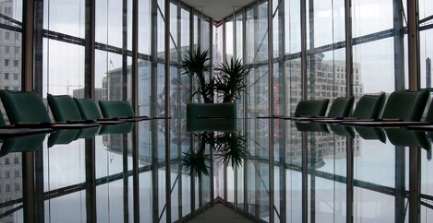Published Thursday, February 14th, 2013, by Mike Sullivan.

Since alternative workplace design promotes an open work environment ? often with no private offices ? conference centers, collaboration spaces, and meeting rooms become very important.
So says Dianne A. Dunnell, a senior associate and project interior designer at Marguilies Perruzi Architects in Boston. And that revelation is a boon to the business center industry ? especially those who focus heavily on meeting room and conference room rentals.
In this series on alternative workplace strategies, we?ve been talking to Dunnell about her practical application of designs in the field. Alternative workplace design encompasses work practices, settings and locations. The alternative workplace model is also known as high performance workspace, workplace transformation or workplace innovation, as it substantially deviates from traditional office designs and practices.
Fostering Greater Collaboration
As Dunnell sees it, alternative workspace design parallels the new way companies are working with common areas that support formal and informal communication, interaction and knowledge sharing, and thereby encourage greater collaboration and work in groups. Your business center doesn?t have to transform itself into a coworking facility to tap into this trend.
?By increasing meeting space, as well as by placing meeting spaces in proximity to work areas and making these meeting spaces less formal, alternative workspace design promotes collaborative work,? Dunnell says. ?The design also includes quiet zones for concentration, featuring high walls, filing cabinets or screens to provide privacy and decrease distractions.?
Finally, Dunnell says, common spaces can include breakout areas with a variety of seating, centralized caf?s, kitchen space, and coffee bars. Some business centers are doing this well, even offering rooftop gardens or outdoor patios.
Communicating Business Center Value
Dunnell also says ? and listen closely ? that companies embracing alternative workspace design are also trending toward corporate conference centers that provide the highest level of technology integration, facility flexibility, and client amenities.
And there you have it. A clear line between alternative workplace strategies and business centers, also known as executive office suites, serviced office space, and corporate conference centers. Business centers are part and parcel of the alternative workplace strategy trend, especially those who offer virtual office space and meeting rooms rentals on demand.
Your job as a savvy business center is to communicate the benefits of your alternative office space to the yet uneducated masses. While experts like Dunnell are making a clear connection between flexible work and business centers, there are still many large and small businesses alike that don?t understand the true value of alternative workspace providers. Even though virtual office space is making headlines, there?s still a lot of office user education to do.
The winners in the age of the changing office space paradigm will be the ones who translate alternative workspace design trends into the business center and communicate the value proposition to entrepreneurs, Fortune 500 companies and every sized business in between.
Image: Potsdamer Platz 11 business center in Berlin, Germany
ABOUT THE AUTHOR
Mike Sullivan
Mike Sullivan is an entrepreneur and marketing professional who tries to keep things humming along as best as possible. From time to time, he updates Officing Today, but mostly he can be found on Skype talking with someone about virtual offices. Connect with Mike Sullivan on LinkedIn.
tornados dr. seuss dr seuss the temptations rush limbaugh sandra fluke green book some like it hot
No comments:
Post a Comment
Note: Only a member of this blog may post a comment.